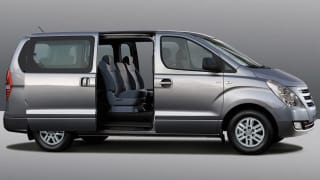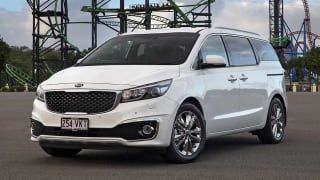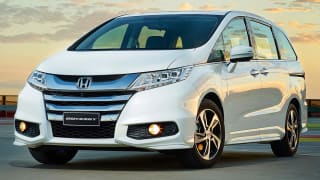Richard Berry road tests and reviews the 2016 Citroen grand C4 Picasso with specs, fuel consumption and verdict.
People movers are the tracksuit pants of the car world. A place where function and comfort completely overrules style. Sure there are some pretty fancy tracky dacks out there, but when it all comes down to it, they are what they are. Even if Ferrari built a people mover with a screaming V12 all it would say is “we like to get to church really quickly”. So, it’s almost as if Citroen has faced this reality and embraced it with the Grand C4 Picasso coming up with a people mover so quirkily functional, it’s dangerously close to being cool.
This second generation Grand C4 Picasso made its global debut at the Geneva motor show in 2013 and arrived here in early 2014. It’s available in Australia in just one spec – the Exclusive – and comes with a diesel engine $44,990.
An updated version appeared recently in Europe, but we’re unlikely to see it here until late 2017 at the earliest.
Design
Google Translate says the French word for quirky is ‘excentrique’. If that’s the case then the Grand C4 Picasso is tres bloody excentrique. Look at it with its enormous glass windscreen and see-through A-pillars, its snub nose those with the headlight low and the high placed squinty LEDs.
Inside things get even more excentrique. There’s a biro-sized gear shifter on the steering column, the hand brake is on the dashboard and the rear vision mirror is accompanied by a miniature twin to help you view the kids in the back.
Those see-through pillars look gimmicky but they improve visibility unbelievably.
The Grand C4 Picasso seats seven, and is 172mm longer than the (not so grand?) C4 Picasso five seat hatch.
You can go from sprog hauler to cargo hauler with all seats – apart from the driver’s – folding flat. The second row is made up of three individually folding seats, while the third row seats disappear into the boot floor when packed away.
Passengers in the second row get fold down tray tables, window sun shades and air-con controls and vents.
Standard features include a gigantic 12-inch display that dominates the upper part of the dash with a mere mortal 7-inch screen below it. There’s also sat nav, a reversing camera, bird’s eye view 360 camera and parking sensors.
The French seem to frown on drinking and driving – drinking anything and driving that is – and like other Gallic automobiles the Grand C4 Picasso has barely any cup holders. There’s two up front but zero anywhere else. You’re not going to fit a bottle of anything in the door pockets either with their letter box-sized openings.
Despite that storage is actually brilliant with a big closable bucket under the dash for wallets and keys and USB connections, while there’s an enormous bin in the removable centre console, yup, removable – the whole thing unclicks and can be lifted out.
The driver’s and front passenger seats are up there with the most comfortable and supportive we’ve ever sat in – great for long distance driving.
The Grand C4 Picasso has a maximum five-star ANCAP safety rating, there’s traction and stability control and blind spot warning. Our test car was fitted with the Tech Pack which was being offered as standard for a limited time, so check to see if Citroen is still doing the deal. The Tech Pack which is worth $5000 extra normally brings an auto tailgate, adaptive cruise control, Xenon headlights and collision alert.
Unfortunately for a people mover, the curtain airbags do not extend to the third row – only to the second, which is a bit disappointing for a car that seems to have every little thing covered.
About town
Those see-through pillars look gimmicky but they improve visibility unbelievably. Improving nothing at all is how all the controls for everything are accessed through either of the two screens. Air con, media, your speed, the gear you’re in – it’s all accessed or displayed through one of the two centre displays. It’s not only frustrating at times to view and operate, but what happens if a screen carks it? Hmm…
There’s no shortage of glass and it’s a pretty bizarre feeling to look up and see the windscreen curving over your head. Fortunately the sun visors are on tracks and extend further down for when you’re pointing into the sun.
The panoramic sunroof completes the glass bubble for a totally 1980s fighter jet video game feel.
I like the shifter on the column, it’s a cool retro touch, but the lever itself is so petite it’s going to come off in some Aussie bloke’s oven mitt-sized hand at some point.
The driver’s and front passenger seats are up there with the most comfortable and supportive we’ve ever sat in – great for long distance driving. The second row seats are also exceptional. Don’t even think of putting an adult in the third row – there’s no room for adult legs and these are best kept for the kids.
You can throw this thing at any speed bump at any speed and it’ll glide over the thing like it’s not there.
There’s a super spacious feel to the cabin helped by the high roof and lack of floor mounted shifter. Being surrounded by glass adds to this feeling.
On the road
But that glass can have its drawbacks too – at first. There may be such a thing as too much visibility. At 110km/h on the freeway it felt like I was piloting one of those bubble helicopters from M*A*S*H, you’ll feel a bit exposed, but it’s something I got used to after a few hours.
The 2.0-litre four-cylinder turbo diesel is a strong engine and with 110kW and 370Nm at your disposal there’s all the grunt you’ll need in a people mover.
Impressing us hugely is the comfortable ride. You can throw this thing at any speed bump at any speed and it’ll glide over the thing like it’s not there. The flipside to this it’s is a bit like steering a bouncing castle at times, but the handling is better than most people movers out there.
The six-speed automatic does a good job, too. After 400km of highway, suburban and city driving our average fuel consumption was 6.3L/100km, only a litre above the official combined figure.











